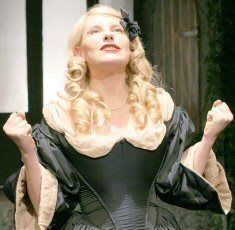In 1697 seven witches were hung at Paisley in Renfrewshire, the last to be executed for witchcraft in Britain, although forty years before the repeal of the witchcraft laws with the Witchcraft Act of 1735 which turned things on their head by making it illegal to pretend to be a person with occult powers. Joanna Baillie must have had these witches very much in mind when, in the mid-1820s, she wrote this play for she grew up in that part of Scotland and would have known their story. Their persecution began with charges that witchcraft was making a little girl ill and Baillie begins her story with a little girl ill and witchcraft suspected.
Writing in prose, Baillie set out to capture the natural speech of the people, using plenty of Scottish words and reflecting Scottish rhythms and this production is played in heavy Scottish accents and often delivered at amazing speed. If, like me, you are a Sassenach who takes a couple of days in Glasgow before you begin to understand what a bus driver is saying to you, you may not find it easy to know quite what's going on. It took me a while to realise that when Lady Dungarren, the child's mother, appeared on a wild heath in a thunderstorm she was not disguised to lead her own coven but the actress doubling as a quite different witch. On the other hand this playing made the dialogue seem much more natural than one might have expected from a poet whose plays contemporary critics sometimes berated as unsuited to the stage. This production makes you wonder why.
Though many treated her as a 'closet' playwright, to be read rather than performed, Baillie certainly she saw hr plays as stage vehicles but she wanted to write about human emotions not provide the stage spectacles that the taste of the time demanded. While still quite literary by today's standards these dialogues would not perhaps have sounded so well if played with the grand style of the day.
It's a neatly plotted story with a young girl, Violet, whose supposedly dead father was condemned as a murderer for killing someone in a fight. She is loved by Robert the Laird but wealthy relative Annabella has her eyes on him and sets out to frame Violet as a witch. The girl is also seen with what a local clergyman believes is the ghost of her dead father (he's actually still alive) so, along with another witch, she is condemned.
The Macbeth witch scenes and the plays of the 18th century Gothic drama have clearly had an influence and, to save the self-sacrificing brave young heroine, the plot resorts to deus ex machina tactics but it is a creditable work and certainly not unplayable, even if on this evidence I wouldn't go along with Sir Walter Scott who thought her the greatest writer of English tragedy since Shakespeare.
Director Bronwen Carr handles it well in this tiny theatre, though one could wish there had been more budget or more skill in the provision of décor. Jason Kirk's lighting, and Matt Downing's sound with rolling thunder, atmospheric traditional harp music and some strange unidentifiable noises do a better job. A couple of minor characters have been lost and those doubled could be more clearly differentiated but her cast largely serve her well, especially John Milroy as Laird Robert and Neil McNulty as a barefoot cowherd with Scott Ainslie as the returned father and Scott McFarlan as the caring cleric. Stephanie Farrell is an appealingly innocent but rather low-key heroine but Allison McKenzie, allowed to be much more histrionic as wicked Annabella, breaks out of the naturalistic style but may be fine when she has matched her performance to the space.
At the Finborough Theatre until 10th May 2008
